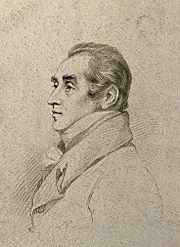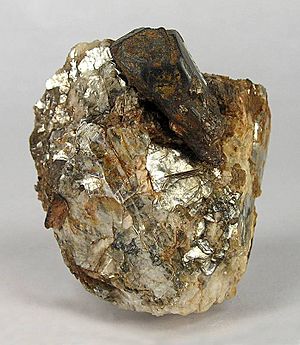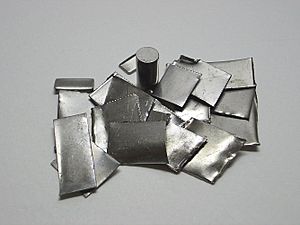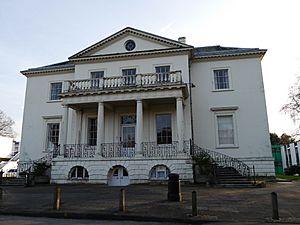Charles Hatchett facts for kids
Quick facts for kids
Charles Hatchett
|
|
|---|---|
 |
|
| Born | 2 January 1765 |
| Died | 10 March 1847 (aged 82) Chelsea, London, UK
|
| Known for | Discovery of niobium |
| Scientific career | |
| Institutions | British Museum |
Charles Hatchett (born January 2, 1765 – died March 10, 1847) was an English scientist. He was a mineralogist, meaning he studied minerals, and an analytical chemist, meaning he studied what things are made of. Hatchett is famous for discovering a new chemical element called niobium. He first named it "columbium."
Hatchett became a member of important scientific groups. He joined the Linnaean Society in 1795 and the Royal Society in 1797. These memberships showed that his scientific work was highly respected.
Contents
Life of Charles Hatchett
Charles Hatchett was born in Long Acre, London. His father, John Hatchett, was a very well-known coach builder in London. Charles went to a private school, but he mostly taught himself about minerals and chemistry.
In 1786, Charles Hatchett married Elizabeth Martha Collick. They had children, including a son named John Charles. Their daughter, Anna Frederica, later married another famous chemist, William Thomas Brande.
After getting married, Charles and Elizabeth traveled a lot in Poland and Russia for two years. They then settled in Hammersmith, England. In 1790, Hatchett traveled again. His father sent him to deliver a coach to Catherine the Great in St. Petersburg. During this trip, he met many important scientists, like chemist Martin Klaproth.
In 1796, Hatchett took another long trip. This time, he explored England and Scotland. He visited places where rocks were formed, mines, and factories. He wrote a diary about this trip, which was published later as The Hatchett diary.
Hatchett's Chemistry Work
Most of Charles Hatchett's important chemistry work happened between 1796 and 1806. In 1796, he published a paper that helped solve a disagreement about a mineral. Because of this work, he was elected a member of the Royal Society in 1797. He wrote more than 20 other papers about the chemistry of minerals and natural materials.
Around 1800, Hatchett might have opened a small chemical factory in London.
In 1798, important government officials asked Hatchett to check the quality of the country's coins. They wanted to make sure the coins were not being mixed with cheaper metals. In 1803, he wrote a long report. He found that the gold coins were good quality.
Hatchett also collected over 7,000 minerals. He sold this large collection to the British Museum in London in 1799. He also helped organize the museum's mineral collection.
Discovery of a New Element
In 1801, Hatchett studied a piece of columbite mineral from the British Museum's collection. Columbite is a very complex mineral. Hatchett discovered that it contained a "new earth," which meant there was a new chemical element inside it. At that time, the idea of an "element" was still quite new.
Hatchett named this new element "columbium" (Cb). He chose this name to honor Christopher Columbus, who discovered America. On November 26, 1801, he announced his discovery to the Royal Society.
In 1802, another scientist, Anders Gustaf Ekeberg, announced he had found a new element called "tantalum." For many years, scientists were unsure if columbium and tantalum were the same element.
Finally, in 1846, a German chemist named Heinrich Rose showed that there were two different elements in tantalite. He named them niobium and pelopium. It was later found that Rose's niobium was the same as Hatchett's columbium. In 1949, the name niobium was officially chosen for element 41.
Hatchett's Later Life
After his father passed away, Hatchett mostly stopped his work as a chemist. He took over his father's coach-making business. He also became interested in collecting books, old papers, paintings, and musical instruments. Other scientists were sad that he stopped his chemistry work. They felt that his new wealth and business kept him away from science.
Hatchett lived at a beautiful estate called Mount Clare, Roehampton from 1807 to 1819. It was described as a "little estate built in a fine Italian style" with a "very well-equipped laboratory" nearby.
In 1818, Hatchett moved to Belle Vue, a house his father had built in 1771 in Chelsea, London. This house overlooks gardens and the River Thames. He lived there for the rest of his life. His wife, Elizabeth, died in 1837.
Charles Hatchett died at Belle Vue House in 1847. He is buried at St Laurence's Church in Slough, where his friend, the famous astronomer William Herschel, is also buried.
Recognition and Awards
Hatchett received important awards for his scientific work. In 1798, the Royal Society gave him the Copley Medal. This is a very high honor in science. In 1828, he was recognized by the Royal Institution. He and other famous chemists like Humphry Davy and Michael Faraday received a gold medal for their discoveries.
Today, Charles Hatchett is still remembered. In 1979, a company called Companhia Brasileira de Metalurgia e Mineração created the Charles Hatchett Award. This award is given every year to a metallurgist (someone who studies metals). It honors the best research on the science and technology of niobium and its alloys. The medal itself is made of pure niobium.
See also
 In Spanish: Charles Hatchett para niños
In Spanish: Charles Hatchett para niños




